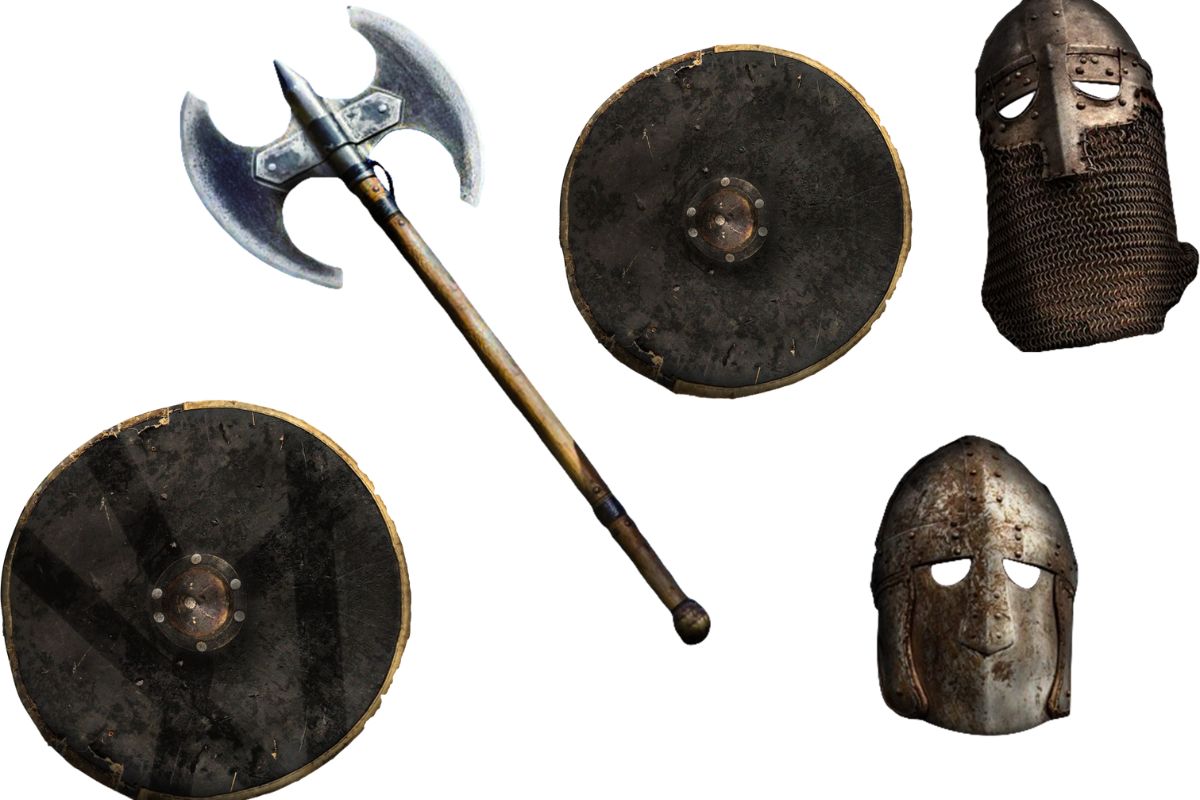The most common Viking weapons were spears and axes, which were cheap and effective. Contrary to widespread belief, swords were not so widespread because they were complicated and expensive to manufacture.
Bows and swords also required a lot of specialized training to master, whereas axes and spears could be lethal in the hands of even the most poorly trained Viking warriors.
Weapons Of The Viking Age
Viking Knives
The Viking seax knife was a short stabbing knife, dagger, or sword typical of the Central Germanic and Norse populations during the Migration Period and the Early Middle Ages.
“Seax” is actually an Old English word for “knife.”
Seaxes were very varied but were mostly carried in a scabbard that hung horizontally from the belt with the cutting edge facing upwards. Many were curved with pattern welded blades and metal bolsters and pommels.

Viking Hammers
War hammers are often depicted as the most typical Viking weapon, Thor’s Mjölnir being the most famous example.
Hammers became more popular as armor became more sophisticated, and swords, spears, and axes sometimes had difficulty penetrating it. However, the impact of an axe could cause terrible blunt-weapon damage without having to pierce the armor.
Mounted troops usually carried shorter-handled hammers.
Many war hammers had a head with a spike on one side and the more typical blunt face on the other. The usual method was to strike the opponent’s head with the flat side and then apply the coup de grace with the spike while they were prone or crouched, stunned, and unable to respond.
Viking Bows And Arrows
Being a ranged weapon, the bow was especially important at the beginning of a battle. A good bow had an effective range of around 200 yards.
Viking bows were usually made of ash or elm because these woods gave the best mixture of strength and flexibility. The bowstring was made of flax, and the total arc of the bow measured about 75 inches.
Arrows came in many different varieties, although they usually featured an iron point.
Viking Axes
The battle axe was a much more common weapon than the sword, mainly because it had practical and destructive uses. Many diverse types of axes have been found; some are highly decorated with intricate silver inlay, for example. However, most are plain and made of basic iron.
The iconic bearded axe was simple and very lethal. The “beard” was the lower section of the bladed part which was wider than the section which met the haft.
Thousands of axe heads have been found in burial sites and archaeological digs. One of the best examples of Viking Age axes is the silver-adorned ceremonial Mammen axe, excavated in Mammen, Northern Denmark.
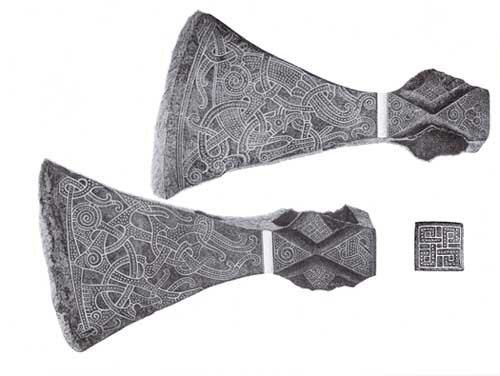
Viking Spears
Spears were the principal weapon of the Viking warrior and the working classes.
They consisted of a six-foot-long wooden shaft and a pointed metal hollow sleeve on the end. The metal part was secured to the shaft by a nail or pin.
Winged spearheads were called krókspjót (or hooked spear), and bladed spears were called höggspjót (or hacking spear).
The thinner and lighter spears were designed for throwing, while the heavier, thicker ones were more suitable for thrusting. Fighting Norsemen tended to use the spears one-handed.
Vikings held spears in high cultural esteem as “Gungnir” was the primary weapon of their supreme god Odin.
As with swords, many spear blades were made using the pattern welded method.
Viking Swords
Only warriors and the wealthiest Vikings, such as merchants or jarls, owned a sword. A sword was the best weapon when it came to mêlée fighting.
Constructing swords was a highly technical and specialized process and took about a month to make. The Vikings had to import most blades from abroad.
Depictions of hordes of Norse warriors, such as Ragnar Lothbrok and his army in the TV show Vikings, all brandishing swords, are a little inaccurate.
Viking swords were about 3 feet long, and blades often featured elaborate carvings decorated with silver or gold. The handle would also feature these precious metals and have an ornate design.
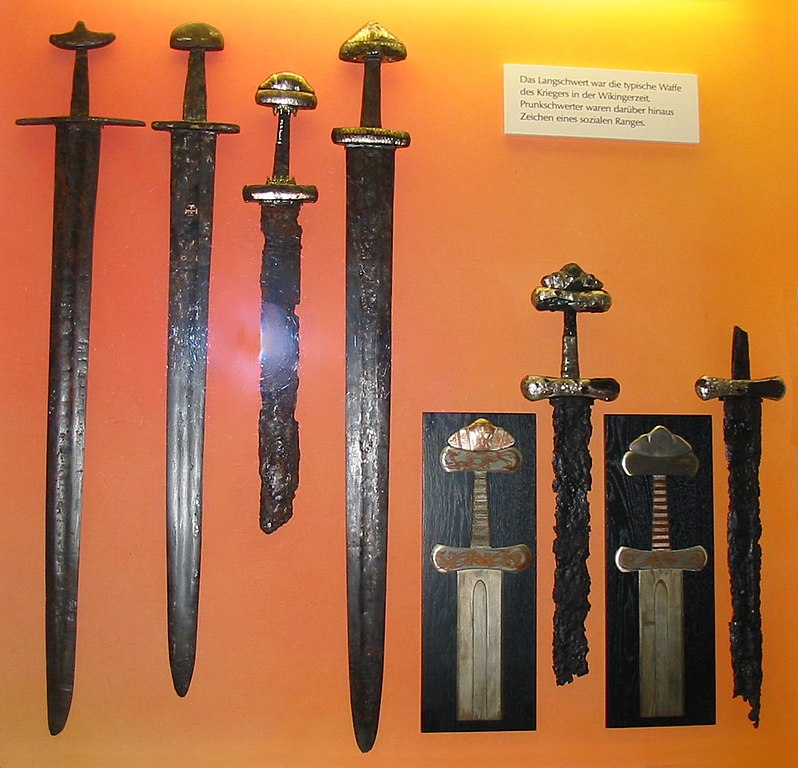
Leg-Biter And Gold-Hit
Vikings often gave their swords names, such as Leg-Biter and Gold-Hilt, and they would sometimes be buried along with their owner. However, as they were so costly, they were more often than not passed on to a family member.
The Viking Age sword was developed in the 8th century from the earlier Merovingian sword of the Migration Period (4th-7th century).
The Laxdæla Saga mentions one sword valued at half a crown or 16 dairy cows.
Bones And Iron
Scandinavian swordmakers inadvertently made their swords more resilient by adding bones to the steel during the manufacturing process. They did this originally to transfer the spirit of the dead into the metal but actually added carbon to the basic bog iron of the Scandinavians, thus creating a kind of rudimentary steel.
About 170 medieval swords were found across Northern Europe with the word “Ulfberht” engraved on their blades. The Hedeby Viking Museum contains some good examples of Viking swords.
Other Weapons
A two-handed long-shafted combined axe and spear known as the atgeir appears in several Sagas of Icelanders. Gunnar Hámundarson is described in the Njáls Saga as cutting and impaling foes on his atgeir.
The Viking age sling, consisting of a rope with a leather cup, was simple to make and allowed the poorer members of Norse society to arm themselves.
Armor And Protection In The Viking Age
Helmets
Helmets were rare as they were expensive, and only the wealthiest Vikings could afford them.
Amazingly, only six Viking-age helmets have been recovered. And of those six, only four have been in Scandinavia. None of the finds had horns, so there is no physical evidence of horned Viking helmets. Ceremonial helmets did have horns, and some bronze age examples have been excavated.
A typical Viking helmet would be made of iron. By inspecting runestones and illustrations, we can deduce that most feature a relatively straightforward design, covering the sides and back of the head and featuring a nose guard.
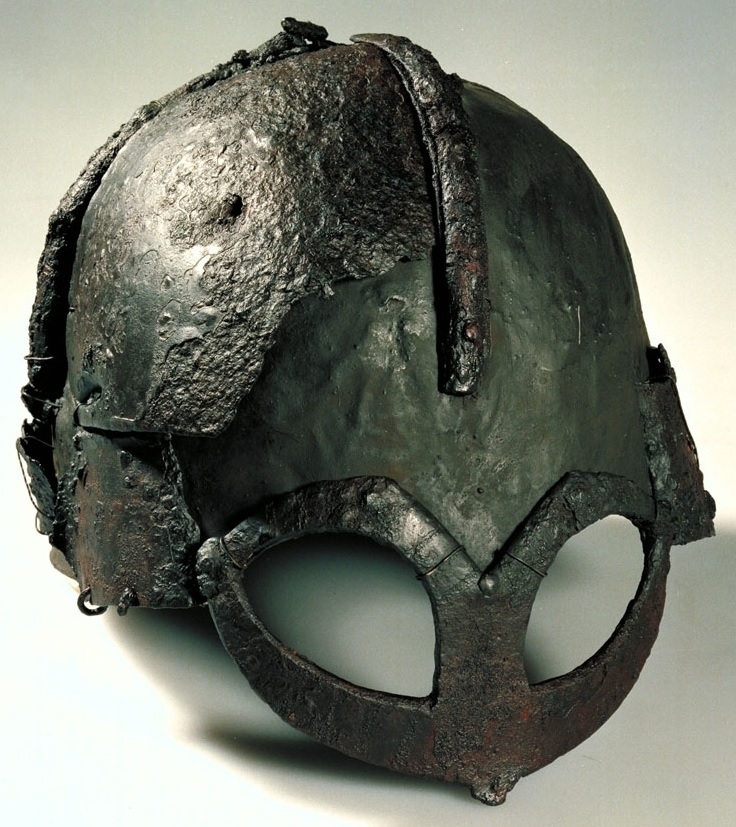
Viking Shields
Mostly used as a defensive weapon, the shield was a particularly important part of the Viking’s arsenal. The Vikings would adopt special defensive formations, either in a long row or a triangle, to create a line or pattern of overlapping shields that would be very difficult to break through.
The shield was also used as part of a Viking’s attacking strategy. They would strike first with it, knocking the opponent off-balance and making them vulnerable to a follow-up thrust with a sword, spear, or axe.

Shields were also an important part of dueling when Vikings would fight with them in one hand and an axe, spear, or sword in the other.
Some Viking-age remains show that many corpses show wounds to the abdomen and legs despite using a shield.
Red For War, White For Peace
Viking shields were round and between 2½ and 3½ feet in diameter. They were made of rectangular wooden planks held together by animal hide and another piece of wood fastened behind them. The shield had a round metal boss (or umbo) in the center and a protective hand grip on the other side. These bosses are usually the only part of the shield that has survived being buried for over a thousand years.
Other evidence shows that some shields were made using two layers of linden wood.
Shields were sometimes painted to indicate the Vikings’ intentions: white meant peace, but red meant war.
Most preserved shields are between a quarter and half an inch thick, although ones up to over an inch have been uncovered. Egil’s saga tells of Þórólfr using a large, thick shield.
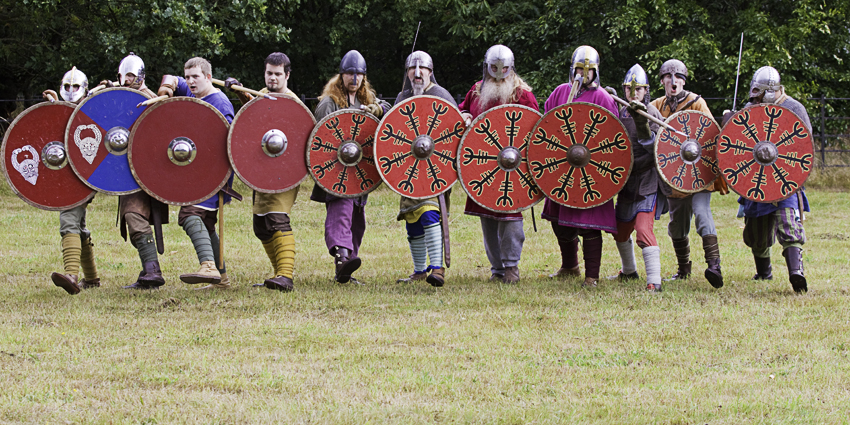
Chain Mail
Only one item of chain mail has been recovered, suggesting that its use was not particularly widespread. Its scarcity was almost certainly due to it being not easy to manufacture, requiring thousands of linked iron rings. Its subsequent expense meant only warriors or men of wealth and status would have worn it.
Viking mail was called “brynja” in Old Norse. It consisted of single riveted rings connecting four solid iron rings, known as the “four-on-one” type.
Lamellar Armor
Lamellar armor consists of small, rectangular bronze, iron, or leather plates laced together.
Cloth And Leather
There are accounts in ancient Norse texts of Vikings using leather armor under their woolen or cloth tunics. In the Heimskringla (The Saga of Olaf Haraldson), the following passage appears:
He had twelve large coats of reindeer skin made for him with so much Lapland witchcraft that no weapon could cut or pierce them any more than if they were armor or ring-mail…
Heimskringla – Baekur Is
Most Vikings seemed to rely on several layers of heavy linen or hemp to protect them from harm. Agile evasion and effective shield use would appear to have been a Viking’s best defense.
What Was A Viking’s Main Weapon?
Spears and axes were the most frequently used weapons.
How Did Vikings Choose Their Weapons?
Expense and ease of manufacture were the main specifications for a Viking choosing their weapon.
Again, spears and axes were the cheapest and easiest weapons to manufacture.
What Made Viking Weaponry So Effective?
Viking warriors were skilled in their use of the axe and the spear and, significantly, their shields. These weapons were perfectly suited to Viking battle tactics, most commonly their surprise raids.
They employed a technique whereby they would stand in a closely-linked line and overlap their shields to create an impenetrable wall of wood and iron.

